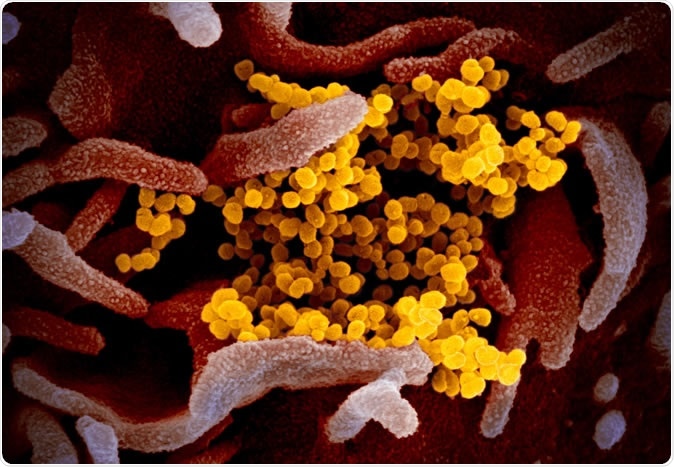Coronavirus disease (COVID-19) is spreading rapidly across the globe. Since COVID-19 is a new disease, scientists are racing to determine the nature of the virus and how it affects the human body. Now, a team of scientists, have shed light on how the virus affects the respiratory tract. The study provides essential information and descriptions of the early phase pathology of COVID-19 infection.
The team, composed of clinicians and researchers from the University of Chicago Medicine and the Zhongnan Hospital of Wuhan University in China, has described the pathology of the severe acute respiratory coronavirus 2 (SARS-CoV-2). The research is published in the Journal of Thoracic Oncology, the official publication of the International Association for the Study of Lung Cancer.

This scanning electron microscope image shows SARS-CoV-2 (yellow)—also known as 2019-nCoV, the virus that causes COVID-19—isolated from a patient in the U.S., emerging from the surface of cells (pink) cultured in the lab. Credit: NIAID-RML
In the study, the team described two patients who recently had lung lobectomies for adenocarcinoma. They were found to have COVID-19 at the time of the surgery. The doctors found that apart from having the lung tumor, the lungs of both the patients had edema, focal reactive hyperplasia of the cells in the lungs with patch inflammatory cellular infiltration, and proteinaceous exudate.
"Since both patients did not exhibit symptoms of pneumonia at the time of surgery, these changes likely represent an early phase of the lung pathology of COVID-19 pneumonia," Dr. Shu-Yuan Xiao, from the University of Chicago Medicine in Chicago, said.
The patients
The first was an 84-year-old female patient who was admitted for a lung tumor measuring 1.5 centimeters in the right middle lobe. A chest CT scan has shown the tumor, but due to underlying health conditions such as hypertension and type 2 diabetes, the patient's condition deteriorated, and she died.
After her death, it was known that the patient was exposed to another patient in the same room who had been found to be infected with COVID-19.
The other patient was a 73-year-old male who was scheduled for lung cancer surgery. He had a small tumor in the right lower lobe. The patient had hypertension for two decades, but he took medicines for it. After his lung surgery, the patient developed cough and fever, with muscle pain and chest tightness. The patient tested positive for SARS-CoV-2 but had recovered after spending twenty days in the hospital.
Studying specimens
Although there had been many studies discussing the clinical features and CT scans of patients stricken with COVID-19, there are no pathologic studies conducted. The researchers said that since the disease emerged suddenly, it has overwhelmed healthcare systems, especially in China.
Further, the urgency of the situation and the outbreak would make an invasive diagnostic procedure less of a clinical priority. The specimens gathered from the patients were accidental findings, showing what changes happen in the first stages of the disease.
The researchers found that even before patients developed symptoms, there had been early lung lesions. This means that even before the symptoms occur, changes are happening in the lung tissue of patients infected with COVID-19, which has a long incubation period of three to 14 days.
The findings of the study emphasize that it would be difficult to contain the virus and prevent its spread because, during the early stages of the disease, there are no symptoms. Many health workers in Wuhan, China, the epicenter of the virus have been infected, mainly because they saw patients without enough protection. More than 15 doctors had died of COVID-19 from infection when they took care of patients with the virus.
"We believe it is imperative to report the findings of routine histopathology for better understanding of the mechanism by which the SARS-CoV-2 causes lung injury in the unfortunate tens and thousands of patients in Wuhan and worldwide," Dr. Xiao said.
Currently, there are ongoing tests and postmortem biopsies to provide more data on the late changes of the disease and its effects on the lungs.
The coronavirus disease (COVID-19) has infected nearly 87,500 people worldwide, a majority in mainland China and 2,990 deaths at the time of writing.
Source:
Journal reference:
Tian, S., Hu, W., Niu, L., Liu, H., Xu, H., and Xiao, S.Y. (2020). Pulmonary pathology of early phase 2019 novel coronavirus (COVID-19) pneumonia in two patients with lung cancer. Journal of Thoracic Oncology. https://www.jto.org/article/S1556-0864(20)30132-5/pdf